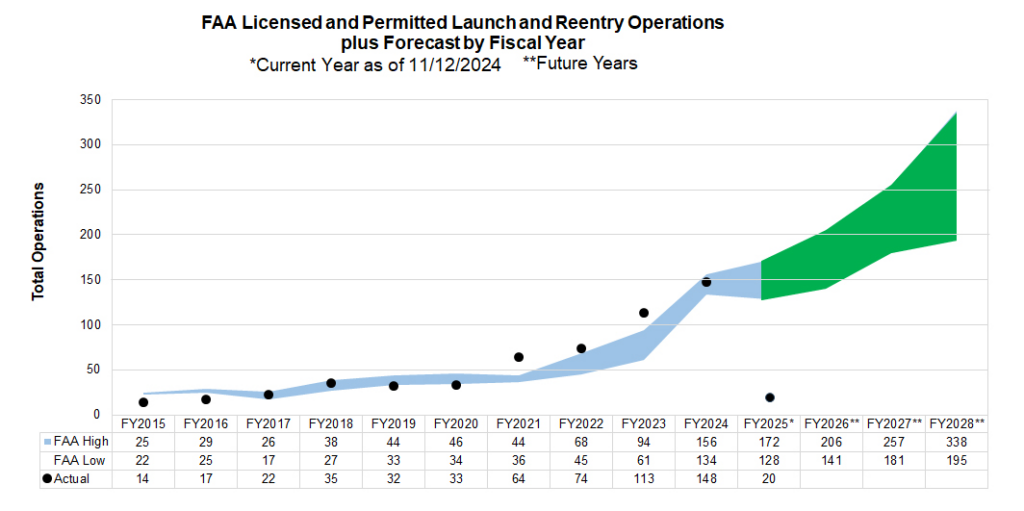The Federal Aviation Administration (FAA) ended Fiscal Year 2024 with an impressive record. It licensed 148 commercial space operations, a 30% increase from the previous year.
Over the past decade, the growth has been even more remarkable—900% since FY 2015.
The surge in licensed launches and reentries reflects the booming U.S. commercial space industry. Companies are pursuing ambitious goals in satellite deployment, space tourism, and cargo missions.
The FAA forecasts these numbers could double by FY 2028.
To prepare for this growth, the FAA is making changes. It plans to refine its Part 450 launch and reentry licensing rule, simplifying licensing and reducing the need for waivers. The rule also aims to streamline processes for both operators and regulators.
The FAA is launching an Aerospace Rulemaking Committee (ARC) to help update Part 450. The committee will include industry and academic representatives and focus on nine critical topics: flight safety and system compliance.
Kelvin B. Coleman, the FAA Associate Administrator for Commercial Space Transportation, explained the significance. He said the updates aim to provide more clarity and flexibility. They also prioritize safety while encouraging innovation.
The ARC’s recommendations are expected by late summer 2025. After that, the FAA will use the input to guide future rule changes. These updates aim to support the industry’s rapid growth while maintaining safety standards.

The FAA’s licensing process has become more efficient over time. It has 180 days to approve or deny a license application by law. The agency meets this deadline 98% of the time.
Part 450, introduced in 2021, marked a significant improvement. It reduced the need for operators to seek FAA approval repeatedly and decreased the number of waivers the FAA must process.
Still, the FAA recognizes the need for further improvements. It has increased staffing to its highest level in 40 years. The Office of Commercial Space Transportation now has 165 employees, up from 118 in FY 2022.
Automation is another key focus. The FAA is developing tools to digitize license applications, speeding up submissions and evaluations and reducing delays.
The agency has also expanded its educational outreach. It offers pre-application consultations, online workshops, and advisory circulars. These resources help companies better understand regulatory requirements.
Preparation plays a crucial role in the operators’ licensing process. Companies can accelerate approvals by submitting complete and well-documented applications. Responding quickly to FAA requests for information also helps.
Another way to avoid delays is to minimize changes during the review period. Proper mission planning can also reduce the need for license modifications. These steps save time and make the process smoother for everyone.
The FAA’s collaborative approach benefits both regulators and industry leaders. FY 2024, it issued seven Part 450 licenses for companies like SpaceX, Relativity Space, and Astra Space.

The FAA completed 49 licensing actions overall in FY 2024. This included two new licenses, ten renewals, and 37 modifications. The office also conducted 23 environmental reviews and 810 inspections.
The agency emphasizes its commitment to safety. It balances efficiency with rigorous oversight to ensure public safety during operations. This dual focus supports the continued growth of the U.S. commercial space industry.
The Aerospace Rulemaking Committee represents the next step forward. Its recommendations will likely shape the future of space regulations. The FAA scheduled the first committee meeting for early December.
Industry and academic participation in the ARC will provide valuable insights. This collaboration strengthens the regulatory framework and ensures the United States continues to be a world leader in commercial space.
The FAA’s actions align with broader national goals. A robust commercial space sector strengthens the U.S. economy and secures the country’s position in the global space race.
The pace of growth in the space industry shows no signs of slowing. As more companies enter the market, the demand for licenses will continue to rise. The FAA is preparing for this with expanded resources and updated rules.
The agency’s forward-thinking approach is evident in its initiatives. Automating licensing tools and offering educational resources reflect a commitment to innovation. These steps also demonstrate a willingness to adapt to industry needs.
The FAA encourages companies to take full advantage of its educational opportunities. Workshops and pre-application consultations offer valuable guidance and help operators navigate the complex licensing process more efficiently.
The agency’s outreach efforts foster a collaborative relationship with industry stakeholders. This partnership is essential for achieving timely licensing approvals and supporting the safe expansion of commercial space operations.
Looking to the future, the FAA is focused on long-term success. Refining regulations and streamlining processes aim to support sustainable growth, benefiting the industry, the public, and the U.S. economy.
The record numbers in FY 2024 highlight the sector’s potential. The FAA’s proactive measures ensure it is ready to meet the challenges ahead. With solid industry collaboration, the U.S. remains on track to lead the commercial space revolution.
